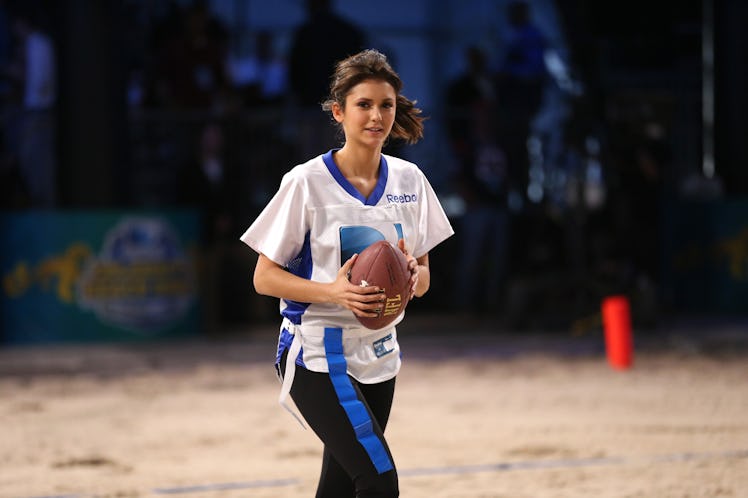
This Video Of Nina Dobrev Sprinting On The Treadmill Makes Her Look Like A Superhero
Jogging on the treadmill is hard. Sprinting on a treadmill? That's another beast entirely. That's why, when I saw a video of Nina Dobrev sprinting on the treadmill (with a freaking resistance band to up the intensity of the sprint, might I add), I officially proclaimed her my new workout idol. You probably will, too, once you see the video. Seriously, it's like she's an actual superhero.
The Dogpound, an exclusive gym in New York City frequented by mostly celebrity clientele, posted a video of the Canadian actress on its Instagram account on Nov. 6. In the video, you can see Dobrev sprint her heart out atop a treadmill, all while a trainer pulls her backward with a resistance band. OK, Nina. I see you. I am also sweating profusely just watching you do your thing, but it's fine. I'm fine.
Real talk, though, Dobrev is kind of making me want to add some sprints into my own treadmill routine. Maybe not the resistance band element, at least at first — that ish looks so hard. But doesn't sprinting just seem like it would kick your cardio workout up a notch? I don't know about you, but I just get so bored on the treadmill. With sprinting, you're basically doing too much and moving too quickly to possibly feel bored. But still, it's obviously a lot harder than regular jogging. So, is it actually that doable for those of us who only dream of accomplishing the graceful speed of Nina Dobrev?
According to David Wiener, a training specialist for fitness app Freeletics, while the movement patterns of running, jogging, and sprinting are similar, sprinting offers a much more dynamic version of cardio. It's more explosive, he tells Elite Daily in an email, and as a result, it offers slightly different benefits than something more steady like running or jogging.
"Sprinting requires additional power and muscle activation, putting more stress on the body, but also strengthening it and increasing your speed and fitness levels," Wiener explains. "This type of exercise, (i.e. short, intensive bursts) is great for revving up the metabolism and [upping intensity]."
Yes, your body will need to put in more effort, he says, but the payoff is that your muscle fibers will work more explosively, and therefore use energy more collectively.
"Sprinting is also a great way to build muscle and train the thighs and the glutes," says Wiener. "To help elevate your run or jog to a sprint, it is important to focus on your core and your posture, driving yourself forward with more power, which can only be maintained in shorter bursts."
That's because, according to the training specialist, when you sprint, your body enters what is called the anaerobic zone, which means it's using glycogen rather than oxygen to fuel your muscles. "Even over short periods of time, glycogen builds up, producing lactic acid, which accelerates that tired feeling and can cause stitches or a burning sensation in your muscles, which is why you can’t sprint for long periods of time," Wiener explains. In other words, this is one workout that's best kept short, fam. Can I get a "hell yeah" from my fellow lazy peeps who love a quickie workout?
If you want to get as much of a challenge as possible in that short amount of time, there are a few different ways to accelerate a sprint workout, according to Wiener. "One such way is using resisted sprints (like Dobrev). The resistance bands act like a parachute, forcing your body to use more muscles and effectively fight harder," the trainer explains.
Basically, the style of training that Dobrev is doing in Dogpound's video creates power and speed, resulting in one of the highest intensity workouts possible, Wiener tells Elite Daily. Again, I'm sweating over here just thinking about it.
If you're not about the resistance band life, though, that's totally fine. "Sprinting on uneven surfaces and uphill will also help to increase the difficulty of a workout and quickly increase your fitness levels," the trainer adds. "Uphill sprinting is equipment-free, but it’s vitally important that you focus on your form to ensure you avoid injury."
Ultimately, the way Wiener sees it, it’s easy to incorporate an element of sprinting into your regular runs or jogs, if that's something you're into. However, it's also important to make sure that you sprint only for short distances, he says, and that you only increase the length of the bursts when you’re genuinely ready to do so. "For example, if you normally jog for 30 minutes, try incorporating 10-second sprints, and building up to 20 seconds, 30 seconds and so on," Wiener suggests, "with recovery in between before another intense burst."